#Nosch
Photo

Color experiment with Nosch using subtle expressions :3
This drawing was done a week ahead of time, and just now posted today!
If you want to get sneak peeks of new illustrations and WIPs be sure to become a member on my Ko-fi under the ‘Kingzvire’ tier! I’ll be working on some Valentine’s Day stuff while also continuing to work on my ongoing series called Kingzvire. It’s only $10/month, and you literally can help keep me fed while making art! How cool is that?! :D
3 notes
·
View notes
Text
POETISCHE SYSTEME: Heidelberg vom 10.03. bis 28.04.2024
Die Galerie Marianne Heller in Heidelberg zeigt in ihrer Frühjahrsausstellung Arbeiten des französischen Keramikkünstlers Emmanuel Boos zusammen mit Bildern des Münchner Malers Günter Nosch.
Emmanuel Boos, Quartett, 2023, Keramik | ©Sebastian Weindel
Emmanuel Boos (geb. 1969 in St. Etienne) erlernte die feine Kunst der Porzellantöpferei bei Maître d’art Jean Girel, ehe er am Royal College…

View On WordPress
#angewandte Kunst#Backstein#Barbara Hohenadl)#Emmanuel Boos#Farbe#Galerie Marianne Heller#Günter Nosch#Glasur#Heidelberg#Keramik#Malerei#Papier#Pflasterstein#Rythmik#surface design#Ton#Würfel
0 notes
Text
Wearing the Cloak: Dressing the Soldier in Roman Times :: Edited by Marie-Louise Nosch

View On WordPress
#978-1-8421-7437-1#ancient roman fabrics#ancient textiles#ancient textiles series#army clothing#army costume#army fabrics#army textiles#army uniforms#books edited by marie-louise nosch#first edition books#historical textiles#history costume#history textiles#italian fabrics#italy history#military history#roman fabrics#roman textiles#uniforms materials
0 notes
Text
Minoan Kilt
The large, structural skirt worn by Minoan women in art is instantly recognizable, and when I made my own I combined current best guesses with my own personal tastes.

My kilt shape follows the hypothesis laid out by Bernice Jones in her book Ariadne's Threads: The Construction and Significance of Clothes in the Aegean Bronze Age. She describes the shape of that of a labrys, a double-headed axe with apparent ceremonial significance in Ancient Minoan culture. This garment may be depicted in Linear-B logogram *166 + we, we-being the backwards-s-shaped squiggle in the center which identifies the piece as a garment.

See pages 336 and 341 in Marie-Louise B. Nosch, The Textile Logograms in the Linear B Tablets
Actual details on construction and materials below the cut:
Construction:
The top and bottom edges of the kilt are concave, so the sides are longer than the middle. This gives the chevron-shape seen on layered kilts in art. In addition, the curved top half makes the skirt flare out, accommodating the hips and giving more freedom of movement to the legs. My kilt measured from my waist to my anklebone at the longest point, and about 1.5 times around my waist.
I chose to make a flounced kilt, with smaller strips of fabric and trim applied to a large base piece, rather than a tiered kilt, in which multiple kilt shapes of varying length are layered one on top of the other, so you end up wrangling 3 layers of fabric around the waist. The flounced kilt saves fabric and gives you a lot more freedom with whatever trim you might want. Jones' diagram for a flounced kilt is seen below:

Unlike the version in the diagram above, I chose not to attach ties to the garment itself both because the linen I used was very heavy and I was concerned about weight, and also because folding the skirt and securing it with a separate tie worked just fine for my tastes. In total I had four flounces: 2 alternating rows each of fabric and fringe.
The vertical edges of most kilts are left plain, probably representing either the selvage or an edge otherwise finished off to prevent fraying. For my kilt, however, I ended up with a couple inches of self-fringe on either side as I adjusted the fabric to the correct width. At least three examples of kilts with fringed vertical edges are known, all three from the so-called "House of the Ladies" in Akrotiri
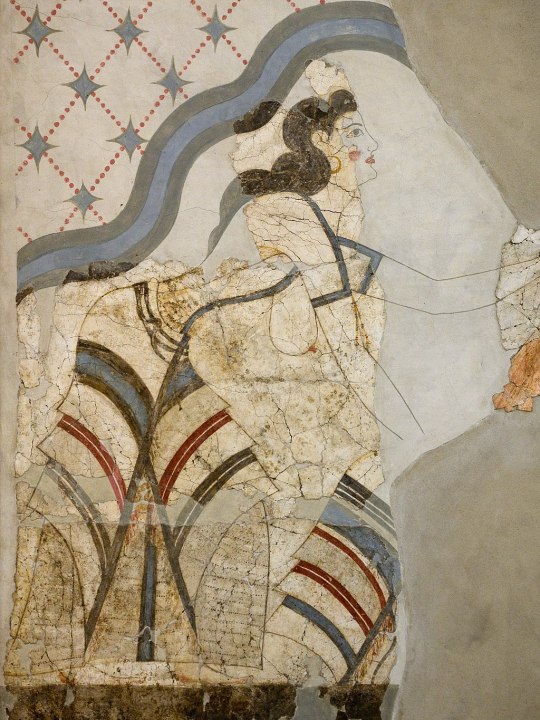

Photos from Wikimedia Commons. Image 1. Image 2.
The vertical edges of these kilts are reinforced with a colored band or tape, probably to keep the garment from unintentional further fraying. Accordingly, I did the same on my kilt. I also like that it gave a nice vertical diagonal to counterbalance the horizontal ones.
Materials
I tried to use mainly linen and wool, the fibers most available on Ancient Crete, but some of my trim was cotton because sometimes you just have to use what's cheap and available in the today times.
The base of my kilt is a heavy, patterned linen in what's called a diaper weave, meaning that a repeating diamond pattern is woven into the pattern itself. A lot of the Minoan textiles depicted in frescoes are characterized by repeating geometric patterns, likely woven into the fabric itself, and that was something I wanted to capture in my own piece. My linen is woven with both cream and natural colored threads. The heavy weight is important to give structure to the garment--otherwise it would be kind of limp. My linen was from Burnley & Trowbridge (shameless plug), as was the plain cotton twill tape I used to bind the top and bottom edges of the kilt, and the dark red wool twill tape I used along the vertical edges.
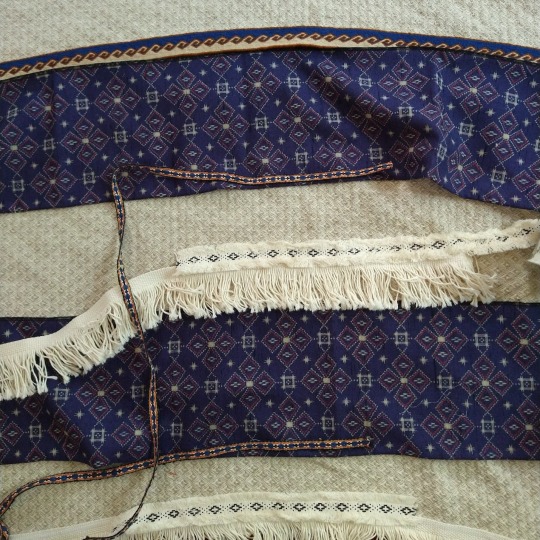
I bought my cotton fringe from a rug supply store. I had to search a while to find a fringe that would work for me, and I ultimately chose fringes with a woven header rather than the more common knotted one, so that it would lay flat against the kilt. I hid the woven header under a layer of cotton fringed trim from Michaels (yes, Michaels) with this really great diamond and dots pattern woven in black.
The blue layers are from a bolt of vintage wool Kimono fabric. Blue appears frequently in frescoes, likely achieved with indigo or woad dye, or even murex/mollusk dye. The fabric is printed with an imitation ikat pattern of diamonds and squares that made me think "the vibes seem right!" because quite frankly, you aren't going to get "historically accurate" Minoan textiles (which there probably isn't enough archaeological evidence to definitively describe) without, like, hand-weaving it yourself or paying someone hundreds of dollars to do it for you (and that price is if the weaver really likes you). Neither of which appealed to my desire to just make a fun, low stress project. Good enough is good enough.
The narrow trim on the bottom of the blue flounces is vintage cotton/poly woven trim. This trim, while narrow, was quite thick and stiff, which was great because it added more weight and structure to the end of my flounces since the wool fabric itself was quite thin.
The top layer is a custom tablet-woven wool trim that I commissioned from MAHTAVAhandicraft on Etsy. I imagined this as the "centerpiece" of my kilt, and I'd arrange everything to complement it.

It's a kivrim pattern, which has itself only been traced to 19th-century Anatolia, but I didn't care. The way it looks like waves reminded me of how central the sea was to life in the Ancient Aegean and Mediterranean and it captured the idea and aesthetic I was pursuing. I mean, doesn't it remind you of these dolphins?

(I like the dolphins)
The whole thing was machine sewn with the exception of hemming and adding trim to the blue flounces. If you were to look at it from the back, you'd see lots of zigzag stitches, because i wanted to be fast! and have fun! not chase some unreachable ideal of "accurate."
As for wearing it, I chose to wear it with the top part folded/rolled down over a belt, so I have a thick tube of fabric around my waist. Many images, like the frescoes above of women with fringed kilts, appear to just show the kilt being tied closed. Other images are so fragmented or stylized that it's unclear what kind of skirt closure was used. Sculptures and figurines definitely show some kind of SOMETHING around the waist, whether this is folded fabric or a kind of belt is unclear. Different art could show different things!
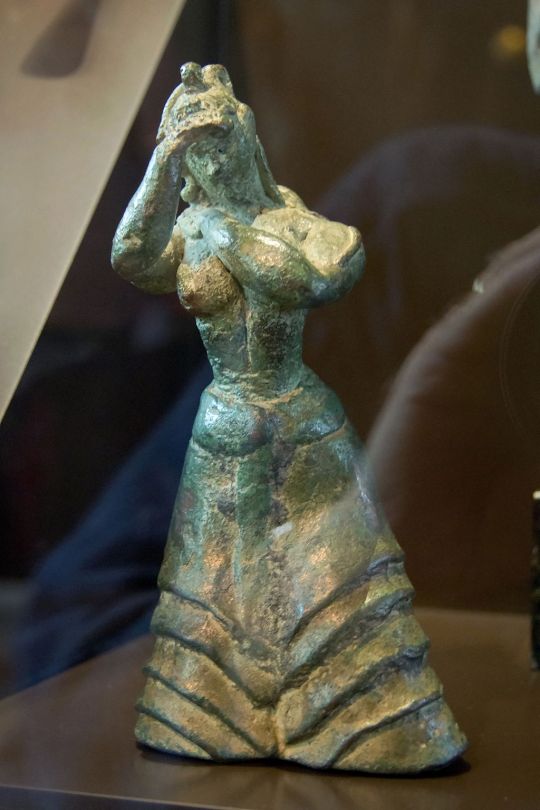
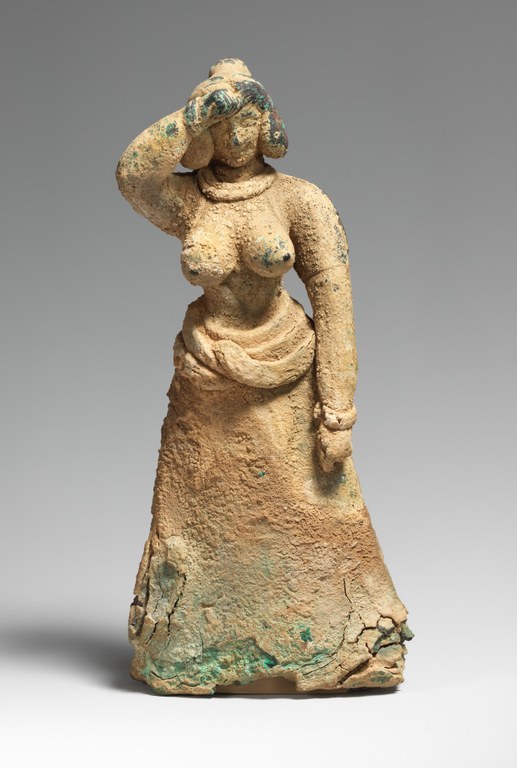
I think I see evidence of a continuous line from the skirt to the waist-roll on the figure on the left, found in Troas, which I think indicates some kind of skirt-folding situation. The woman on the right, found in Crete, looks more like she's wearing some kind of long coiled belt, or perhaps snakes. Who knows? I don't! For my own part, I found the combination of rolled waist + tie belt the most secure for doing things like kneeling, stomping around, and wading into rivers to rescue bees. I also liked that it gave me the bulk around the hips that gives Minoan figurines such a powerful silhouette, and proportionally gives more of an hourglass shape. If you wanted to do something more firmly grounded in the sources, stick just with the waist tie or belt, wrapped around a couple times and tied in back. If you want to be like me, just say "well we don't KNOW it didn't happen" and just do whatever you want. Have fun! Whatever happens, it should be fairly easy to move around in the kilt--this is not a restrictive garment, just a heavy one.
805 notes
·
View notes
Note
Hey, I just saw your post about textile metaphors left in the language, and I want to rec you a book you might be interested in, but, like, it's going out of print so maybe go find it at the publisher's site. Oxbow Books. Spinning Fates and the Song of the Loom: The Use of Textiles, Clothing and Cloth Production as Metaphor, Symbol and Narrative Device in Greek and Latin Literature, edited by Gionvanni Fanfani, Mary Harlow, and Mari-Louise Nosch.
Thank you!
10 notes
·
View notes
Text
“The sanctuary of Eileithyia at Amnissos, known from numerous later literary sources, is the sole case of a sanctuary that is considered to have been identified in excavation and is attested by the Knossian tablets. The frequent reference to Amnissos in the administrative records of the early LM IIIA:2 period is perhaps due to the particular importance of the coastal site as one of the two harbors of Knossos (Davaras and Masson 1983, 383–384; Schäfer 1991, 111–112). The first line of the leaf-shaped tablet Gg(3) 705 from the West Wing of the palace of Knossos records the dispatch of an amphora of honey to Amnissos for e-re-u-ti-ja. This name is transcribed into alphabetic Greek as Eleuthia/Ἐλευθίᾱ, and she has been identified as the goddess of childbirth Eileithyia, known from Homer and many other ancient authors and scholars (Ventris and Chadwick 1956, 310; Aura Jorro and Adrados 1985, 244). . . . Concerning the etymology of the early type Eleuthia, various interpretations have been proposed, the most probable reducing it to an Indo-European root meaning “free of weight,” and possibly referring to the goddess’s role as midwife (Ruipérez and Melena 1996, 187). According to another viewpoint, it derives from the root eleuth- of the verbal type eleusomai (to come, to arrive), while arguments that the name is of pre-Hellenic provenance have also been formulated (Frisk 1960, 456; Schäfer, ed., 1992, 84).
The reference in Homer’s Odyssey (19.188–190) to the cave where the goddess was worshipped at Amnissos echoes the fame of the cult practiced there at least during the Late Minoan period. The initial association of the cave found at Amnissos by I. Hazzidakis in 1885 with Eileithyia was based on this particular passage in Homer (Marinatos 1929, 95). The excavations conducted subsequently by S. Marinatos between 1929 and 1938 confirmed the use of the cave from Neolithic into Late Minoan times, as well as during the Geometric, Hellenistic, and early Roman Imperial periods (Marinatos 1929, 97, 99, 103; 1930; Betancourt and Marinatos 2000). During historical times “mogostokos” Eileithyia, that is, the goddess who brought the pangs of childbirth, was worshipped all over Greece and was identified by various variations of her name in the local dialects: Eleuthyia in Crete, Eleuthia or Eleusia in Laconia, and Eleuthie in Ionia (Frisk 1960, 455). She was particularly popular, however, in many cities of Crete, including Lato, Inatos, Aptera, and Amnissos (Nosch 2009, 27). Although it has been maintained that during the first millennium b.c. a fusing of Eileithyia with Artemis took place (Antoniou 1980, 228–229), it is noteworthy that both deities are recorded independently in the Linear B tablets from Knossos and from Pylos, respectively. The question of the continuity of worship in the Amnissos Cave remains open (Schäfer, ed., 1992, 84); nevertheless, the reference in the Knossian documents to the sanctuary of the goddess advocates the origin of the late cult of Eileithyia from an earlier Minoan goddess of childbirth (Nilsson 1949, 30; Willetts 1962, 168–172).
The brief text incised on the Knossian tablet Gg(3) 705 by Scribe 140, from the Chamber of the Jewel Fresco (Olivier 1967, 85) provides a pretext for certain hypotheses relating to the nature of worship at the site. Honey played an important role in cult, as indicated by the large number of Knossian tablets recording this item. The quantity of honey offered is stated in tablet Gg(3) 705 by the logogram *209VAS, denoting a fixed unit, the precise capacity of which is not known (Ruipérez and Melena 1996, 187). Nonetheless, the attribution of a corresponding quantity “to all the gods” (pa-si te-o-i), in the second line of the tablet, allows us to assume that Eileithyia was the principal deity of Amnissos. Recorded in the third line also is an amphora of honey, which is offered to another deity, whose name is only preserved fragmentarily. Proposed is the restoration of the dative case e-ne-si-da-jo-ne of the possible name of a male divinity, Ένεσιδάhων (Enesidahon; Aura Jorro and Adrados 1985, 219), who is associated with Amnissos in tablet KN M 719 by the same scribe, from the same space. According to some researchers, this is an epithet qualifying Poseidon (Jorro and Adrados 1985, 219). . . .
Tablets KN Od(2) 714.b and Od(2) 715.a, by the specialist Scribe 103 from the Chamber of the Jewel Fresco (Olivier 1967, 44–50, 131–132), concern one other aspect of the economics of worship. Eileithyia receives from the Knossian bureaucrats one intact unit of wool, which is equivalent to 30 kilos of the product, while in tablet Od(2) 716.a she perhaps receives an additional four units of wool. The destination of these offerings is not stated, but it is perhaps related to craft-industrial activity, since the names a-*65-na and ta-wa-ko-to, recorded in these registers, are of persons in a weaving workshop (Enegren 2008, 98, 173). By analogy with the sources of historical times (Soph. OC, 461–493) regarding the dedication of offerings to the gods, it has been proposed that the wool was perhaps intended for the adornment with garlands of the amphorae of honey (Weilhartner 2005, 45).7.”
- Georgia Flouda, The Goddess Eileithyia in the Knossian Linear B Tablets
2 notes
·
View notes
Text
‘Get to know you better’ ask meme.
Saw this on @monstersandmaw and wanted to try it out :’3
Favorite color(s): Red, purple, orange, and turquoise (basically sunset colors~)
Currently reading: Male Dremora x Female Character (Ch.7) by @monstersandmaw , and Death Heads Deal (latest chapter #13) by @niuniente
Last song: Meteor Garden 2018 Full Album OST
Last series: Boruto (on ep. 152 currently in the series) , and Tokyo Mew Mew New ep. 4
Last movie: Aladdin (2019)
Sweet/spicy/savoury: Probably savoury over the two. I like sweet and spicy only with certain things. For example, donuts for sweets and crawfish etoufee for spicy. I don’t like a lot of spicy foods though, but I can go for savoury stuff def!
Currently working on: Art - Death-Heads Deal OC Raynard Character Ref Sheet, and Nosch Kingzvire art. Writing - Not really much, but have some stuff I’m working on like ‘Under the Blood Moon part 2′ and a short snippet on my DHD OC Raynard’s backstory.
Tagging: Anyone who wants to do it! No pressure if you don’t want to though :’3
2 notes
·
View notes
Text

Thursday, 30 November 2023, 12 pm ET (US & Canada)
Online Zoom Lecture
70 Years of Wa/ondering: The Pylos Ta series and Mycenaean Ceremonies
TOM PALAIMA (Department of Classics & Program in Aegean Scripts and Prehistory, University of Texas at Austin)
The thirteen tablets of the Ta series at Pylos are arguably the most informative set of documents pertaining to paraphernalia used in ceremonies and rituals in the Linear B corpus.
The contents of the Ta tablets are diverse and significant for research in Aegean cultural history. There are a. clearly drawn ideograms of ceremonial vessels along with phonetic renderings of their names: pouring vases, receptacle vases, ritual heirloom tripods; b. references to the materials used to construct and decorate pieces of furniture; c. descriptions of abstract or figural motifs of decoration; d. observations on the state of repair of specific objects; e. likely identification of the region of manufacture of particular items (ke-re-si-jo); f. entries referring to implements connected with sacrificial actions (pa-sa-ro, wa-o and qi-si-pe-e) and equipment to use with fire (au-te, pu-ra-u-to-ro, -qa-ra-to-ro and e-ka-ra); g. inlaid tables (whether slaughtering tables or banqueting tables is now under discussion) with varying numbers of ‘feet’; h. throne and stool ‘sets’, other stools.
All this rich and detailed, if occasionally tantalizingly opaque, information was registered as the results of an inspection inventory involving a person named pu2-ke-qi-ri, whose status as an elite functionary, perhaps even a collector, is undebatable, although whether he is the actual tablet-writer of the Ta series and other important tablets that are identified as the work of Hand 2 is still being discussed.
Moreover, the header line for the Ta set specifies that the records were written on the occasion when the king (wa-na-ka) did something important (te-ke) with regards to an individual named au-ke-wa and the significant office of da-mo-ko-ro. What he did is in my view no longer a settled matter nor should it ever have been thought to be.
There are also other important socio-political terms embedded in the descriptions of individual items: for example, wa-na-se-wi-ja and a-mo-te-wi-ja.
I have myself turned to this series periodically since I wrote 49 years ago, as an advocatus diaboli, my M.A. thesis in fall semester 1974 trying to prove to myself and Emmett L. Bennett, Jr., that the tablet writer of the Ta series really was not Hand 2, but Hand 1, the master record-maker, whom Hand 2 closely resembles.
What I will do here today is give a reading of these texts that demonstrates how problematical it is (1) to address critical questions relating to their interpretation looking for either-or solutions; and (2) to keep the forest in mind when studying the roots, bark, branches and leaves of the trees and vice versa.
For seventy years now, the full Ta series of thirteen tablets (discovered in the 1952 excavation season at Pylos) has hardly ever not been under discussion. However, the last five years have seen a veritable renaissance. Behold:
Pierini, Bernabé, Ercoles (eds) 2021. THRONOS: Historical Grammar of Furniture in Mycenaean and Beyond.
Morton, J., N. Blackwell and K. Mahoney 2023. “Sacrificial Ritual and the Palace of Nestor: A Reanalysis of the Ta Tablets,” AJA 127.2, 167–187
Palaima, T.G. and N.G. Blackwell 2020. “Pylos Ta 716 and Mycenaean Ritual Paraphernalia: A Reconsideration,” SMEA NS 6, 67–95.
Blackwell, N.G. and T.G. Palaima 2021. “Further Discussion of pa-sa-ro on Pylos Ta 716: Insights from the Ayia Triada Sarcophagus,” SMEA NS 7, 21–37.
Perna, M. and R. Zucca 2021. “Il ta-ra-nu nel Mediterraneo antico,” in THRONOS, 97–104.
Petrakis, V. 2020. “Mycenaean thórnoi, Homeric θρόνοι: Textual Perspectives,” in L. Nosch, D. Brostowsky Gilboa (eds) The Ancient Throne: The Mediterranean, Near East, and Beyond, from the 3rd Millennium BCE to the 14th Century CE, 61–84.
Pierini, R. 2021. “Mycenaean Wood: Re-thinking the Function of Furniture in the Pylos Ta Tablets within Bronze Age Sacrificial Practices,” in THRONOS, 107–135.
Piquero, J. 2021. The Tables of the Pylos Ta Series: Text and Context, in THRONOS, 43–53
Díez Platas, F. 2021. “Imagining Chairs: Models and Representations of Mycenaean thronoi,” in THRONOS, 75–88.
Aura Jorro, F. 2021. Las interpretaciones de la serie Ta de Pilo en su context,” in THRONOS, 7–30.
Bernabé, A. 2021 How to Describe Things? Depictions of Tables on Mycenaean Tablets and in Present Day Furniture Catalogues, in THRONOS, 55–64.
Varias, C. 2016 “Testi relativi a mobilio e vasi pregiati,” in M. Del Freo, M. Perna (eds) Manuale di epigrafia micenea. Vol. 2: 551–563.
Murphy, J.M.A., S. R. Stocker, J. L Davis and L.A. Schepartz 2020. “Late Bronze Age Tombs at the Palace of Nestor at Pylos,” in J. M. A. Murphy (ed.) Death in Late Bronze Age Greece, 26–44.
Palaima, T.G. 2021. “Mycenaean *a-mo-te-u, Greek ἁρμόζω, and the Ideology of Joining,” MASt@chs Harvard Center for Hellenic Studies February 5, 2021. https://classical-inquiries.chs.harvard.edu/mastchs-winter-2021-seminar/ §§1–13.
Palaima, T.G. Forthcoming. “Historical Reflections on the Pylos Ta Series: Putting te-ke in Its Place,” in J. Bennet, A. Karnava and T. Meißner (eds) KO-RO-NO-WESA: 2021. Rethymno: School of Philosophy, University of Crete.
Zoom participation is limited to 300 people and registration is required. To register, please click here.
0 notes
Text
Motors For Negative Pressure Air Fan suppliers
Motors For Negative Pressure Air Fan suppliers Our History 1972: State owned Wenling Micromotor Factory Co., Ltd. 2008: Wenling Nosch Motor Co., Ltd. 2018: Zhejiang Fangyuan Sifu Mechanical and Electrical Co., Ltd. 2019: Establish Shandong Branch 2020: Establish Foreign Trade Department Our Factory Zhejiang Fangyuan Sifu Mechanical and Electrical Co., Ltd. is a high-tech enterprise focusing on motor R&D, manufacturing and sales. It is one of the core enterprises in the manufacturing sector of China's top 500 private enterprises under the Fangyuan Group. The company's main products include iron-shell single three-phase asynchronous motor series, aluminum-shell single three-phase asynchronous motor series, fan special motor series, frequency conversion motor series, permanent magnet DC motor series, etc. Mainly used in water pump power, fan power, machine equipment power, agricultural machinery power, new energy vehicle power, marine equipment power and other fields. The company is located at No. 2479, Haifeng Road, Taizhou Bay New District, Zhejiang (3 kilometers from the east exit of Jiaojiang Coastal Expressway, 10 kilometers from Taizhou Airport, and 20 kilometers from Taizhou High-speed Railway Station).Covering an area of 43 acres, it has a standardized workshop of 35,000 square meters, equipped with more than 50 sets of automatic CNC lathes, CNC grinders, CNC milling machines, machining centers, high-speed punching machines and other metal processing equipment, and equipped with advanced equipment such as automatic wire embedding lines, spraying lines, and automatic assembly lines. There are domestic leading wind tunnel laboratories, test centers, and motor type laboratories. The company has a technical management team with strong professional skills and excellent management capabilities. So far, it has obtained dozens of patent certificates (including 5 invention patents), participated in the formulation of 4 industry standards, and obtained 3C certification, CE Certification, ISO9001 management system certification, ISO45001 occupational health and safety management system certification, ISO14001 environmental management system certification, etc. It has also launched long-term technical cooperation with universities such as China Jiliang University and Zhejiang University of Technology to enhance core power in terms of innovation, stability, high efficiency, and energy saving. Our Product 鈼?IE3 Premium Motor 鈼?IE4 Super Premium Motor 鈼?Single Phase Motor 鈼?FRP Fan Motor 鈼?Negative Pressure Fan Motor 鈼?Cooling Fan Motor 鈼?Exhaust Fan Motor for Cowshed 鈼?Portable Cooler Motor 鈼?Vertical Pump Motor 鈼?Acid and Alkali Resistant Chemical Pump Motor 鈼?Washer Motor 鈼?Special Motor for Woodworking Product Application FRP Fan, Negative Pressure Fan, Cooling Fan, Exhaust Fan, Portable Cooler, Vertical Pump, Acid and Alkali Resistant Chemical Pump, Washer, Woodworking Our Certificate CE, Reach, RoHS, CCC (China Compulsory Certification), IPMS, China Energy Label Production Equipment Automatic wire embedding machine: 10 CNC lathe: 12 CNC grinder : 4 Dynamic balance machine: 4 CNC milling machine: 3 Plastic spraying line: 1 Production line: 9 Paint dipping machine: 2 Multi hole drilling machine: 2 Production Market Annual Output Value: US$20- US$50Million Domestic Market: 55% Eastern Europe: 10% Southeast Asia: 10% Middle East: 5% Africa: 5% South America: 3% Western Europe: 3% Other Areas: 9% Our Service The company takes the spirit of innovation as the guideline, takes high-quality products as the foundation, and takes full-staff entrepreneurship as the core driving force, strongly promotes R&D and innovation, accelerates the adjustment of product structure, optimizes technical processes, improves operational efficiency, and strengthens the spirit of chemical craftsmanship, and uses this as a driving force to build Outstanding enterprise, creating market opportunities, and striding forward to the vanguard of industry segmentation.Motors For Negative Pressure Air Fan suppliers website:http://www.sivomotor.com/
0 notes
Text
Quạt hút Composite 850x850

Quạt thông gió composite là dạng quạt công nghiệp lưu thông không khí tuần hoàn không khí trong nhà xưởng, với ưu điểm về lưu lượng gió lớn và độ ồn thấp, lắp đặt trên tường tích kiệm diện tích, quạt thông gió công nghiệp là một trong những giải pháp lưu thông và giảm nhiệt độ rẻ tiền và hiệu quả nhất hiện nay cho các việc thông gió nhà máy, và thông gió trang trại.
Quạt hút thông gió composite
Quạt thông gió composite là dạng quạt được làm bằng nhựa composite với tính năng chống ăn mòn tuyệt đối và không bị biến dạng trong nhiều môi trường ẩm ướt có hóa chất và chất thải.
Quạt hút composite có có độ ồn thấp nhờ thiết kế dạng loa và thiết kế chống mưa hiệu quả khiến quạt thông gió composite là một trong những sản phẩm được nhiều nhà thầu và chủ đầu tư tin tưởng sử dụng trong nhà xưởng và trang trại.
Cấu tạo của quạt hút thông gió composite
Quạt thông gió composite có cấu tạo thân vỏ quạt được làm bằng nhựa composite loại nhựa công nghiệp có độ bền cao, chống được nắng mưa và có thể chịu va đập mài mòn theo thời gian.
Quạt hút thông gió composite có cấu tạo lá chớp. ngược khi quạt hoạt động lá chớp sẽ được hút ngược trở lại thân vỏ giúp việc lưu thông không khí và hút không khí được tối ưu hơn các loại quạt thông gió tôn kẽm.
Khung giá đỡ động cơ được làm bằng inox chống ăn mòn cao.
Quạt hút composite được sử dụng cánh quạt composite chống ăn mòn, chống va đập với 6 lá cánh chủ động với góc nghiêng tiêu chuẩn luôn tạo ra lưu lượng gió lớn và tốc áp lực gió cao.
Động cơ quạt thông gió composite được sử dụng các dạng động cơ chất lượng như động cơ Nosch chính hãng.
Quạt được cấu tạo hoàn toàn bằng các vật liệu chống ăn mòn nên luôn được ưu tiên sử dụng trong các trang trại và khu công nghiệp, nhà kho có hóa chất ăn mòn.
Quạt thông gió composite có 2 dạng chuyển động phổ biến là.
Quạt thông gió composite chuyển động gián tiếp.
Quạt thông gió composite chuyển được trực tiếp.
Và có thiết kế khá đặc biệt hơn các dạng quạt khác là có thể lắp thêm loa để quạt giảm tiếng ồn khi sử dụng ở những vị trí đông dân cư mật độ công nhân đông.
Thông số kỹ thuật quạt hút thông gió composite
- Thông số kỹ thuật
- Nhà cung cấp: Hưng Đức Phát
- Tên sản phẩm : Quạt hút thông gió composite
- Điện Áp: 380V/50HZ (3pha)
- Công suất : 0,37KW
- Đường kính cánh: 650
- Tốc độ gió m/phút: 545
- Lưu lượng gió : m3/h: 28000
- Độ Ồn:
Read the full article
0 notes
Text
Muchas veces nos pasamos la vida pensando que estamos vivos; cuando en realidad andamos por el mundo sin algún propósito, ó peor sin deseos de recorrerlo.
Me siento muchas veces así, tan decaído que pienso en dejarme caer al vacío sin pensar en que pasará después. Simplemente caer como una hoja a un mar de maldades las cuales nunca llenarán la vida de nada, al igual que las verdades.

No me encuentro triste... Pero tampoco estoy feliz.
1 note
·
View note
Text
Kingzvire Couple Sketches

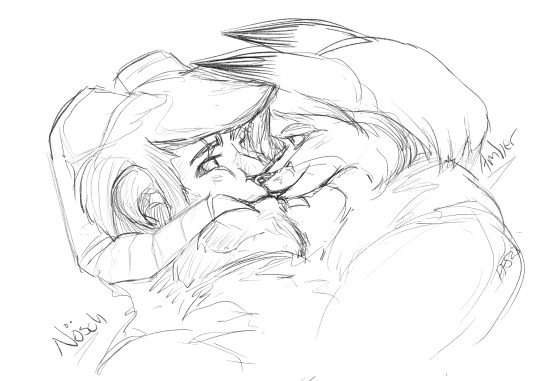
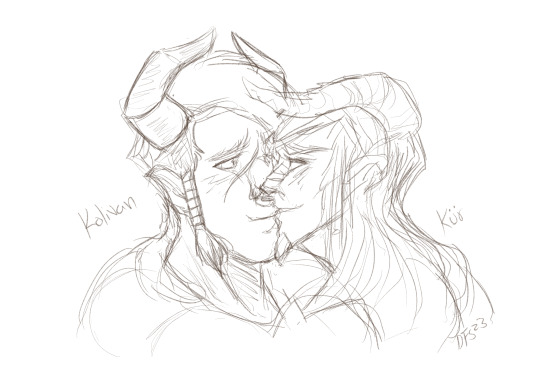
#Kingzvire#Valentine's Day#Couple Portraits#Sketches#Art by DragonFoxStar#DragonFoxStar Designs#Kur#Kolivan#Nosch#Amber#Aura#Jasper
2 notes
·
View notes
Photo

Also never posted this pic of Nosche’s redesign??? I have so much shit i never posted which is bullshit but that’s the life of a forgetful fucker.
11 notes
·
View notes
Text
necesito una compañera que soporte el cariño, tiempo, espacio y confianza, es lo unico preciado que tengo. u.u
even time die.-
#notas#preciado#letras#un chico escribiendo#penas#tristeza#soledad#tiempo#libreta#noche#noches de insom#nosches solo#siempre solo#quiero estar contigo#me haces falta
1 note
·
View note
Text
Minoan Heanos
The distinctive open-front dresses worn by Minoan women are probably even more iconic than the multi-layered kilts. Over time, there's dispute whether the garment is one piece or a separate bodice and skirt, but currently the one-piece theory is in ascendance.

The word heanos is derived from the Linear B logogram *146, wehanos. The wes- prefix, which is the squiggle in the middle, indicates a garment. Bernice Jones believes that this logogram represents the garment worn by Minoan men and women.
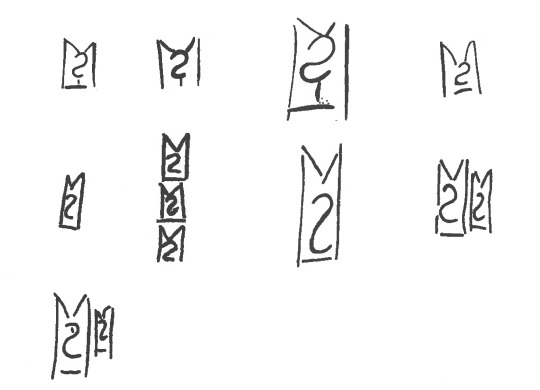
Marie-Louise B. Nosch, The Textile Logograms in the Linear B Tablets, pp 133-138
More research and construction below the cut:
The theory that the garment is a full-length tunic is further supported from imagery from the time, like these figures from the c. 1400 BCE Hagia Triada Sarcophagus. This detail from the sarcophagus shows three figures in some kind of procession, 2 women and 1 man. The woman at left wears a tunic with some kind of pelt as a skirt, and the other 2 figures wear tunics without anything over them, showing that they are one continuous, ankle-length garment.
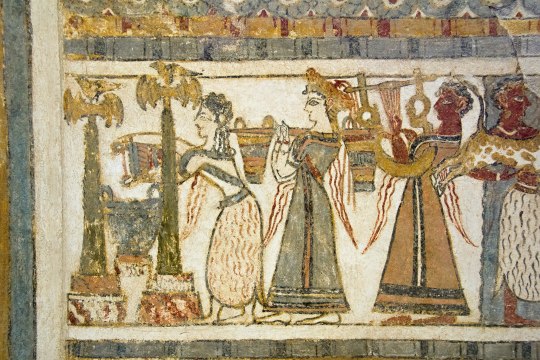
Some of the most important resources for interpreting how the heanos was constructed comes from the two women depicted in the House of the Ladies in Akrotiri, wherein the side seams of the tunic are clearly visible running along the side of the body and under the arm.
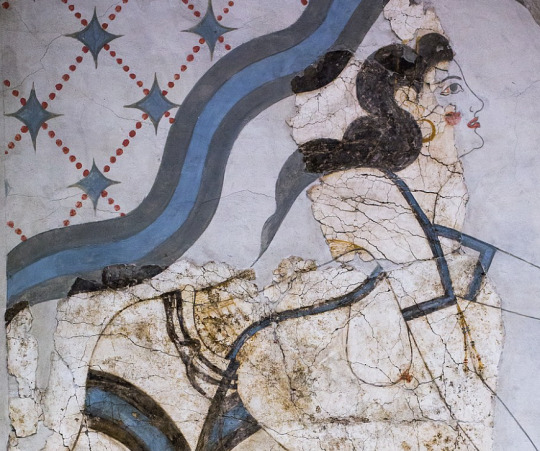
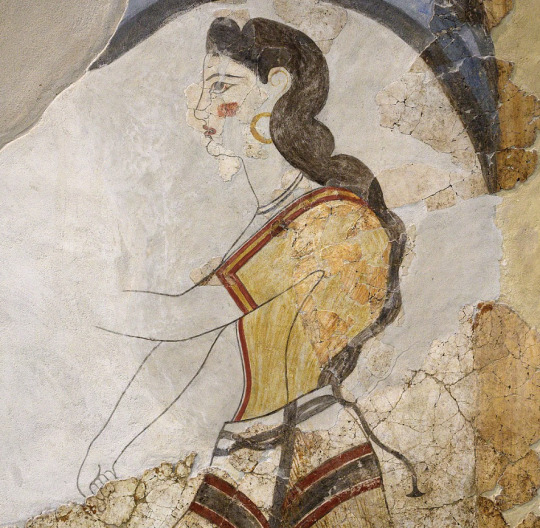
details of figures from the House of the Ladies, Akrotiri, via Wikimedia Commons
advadbsvasb
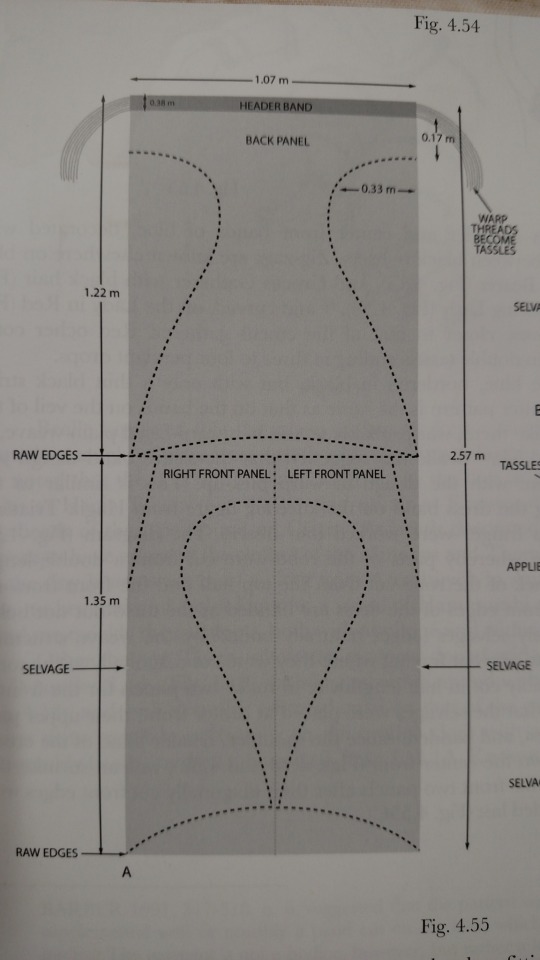

Diagrams from Bernice Jones' book Ariadne's Threads, p. 82, via Gorgeous Tangents
The heanos itself is made of 3 pieces of fabric: 1 back and 2 fronts. These diagrams show a concave hem like on the labrys-shaped kilt but I went with a straight hem, which is an equally valid option. The end of the sleeves are level with the edge of the hem at the widest point. This would probably be the width selvage-to-selvage on the fabric, being narrower than fabric widths commonly are today. There are 4 seams: the shoulder seam, the two side seams, and a front seam (optional, but recommended if you would prefer not being arrested.) It may be tempting to fold the fabric across the shoulder, so the only sewing is side seams and a neck hole, but this makes a weaker garment overall. I used this as a shortcut in my fitting muslin and it caused tears and weak points at the three points of the front opening.

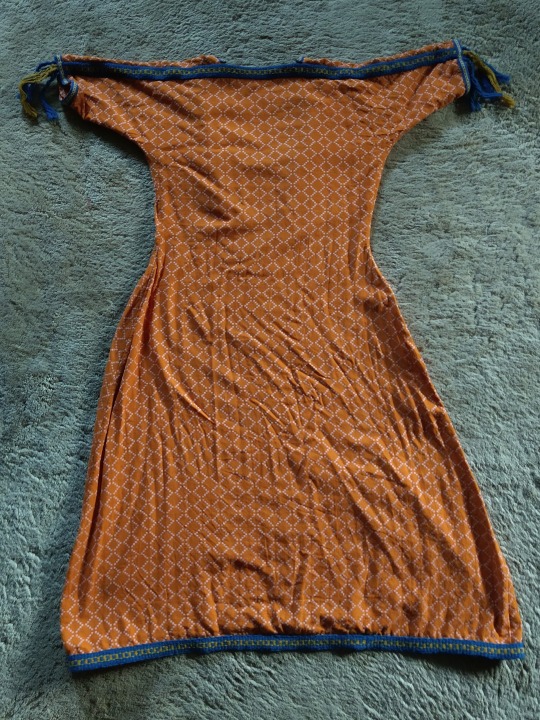
my fabric was a lightweight, moderately loose-woven cotton with a supplementary weave pattern in squares and diamonds. Linen or wool would have been more accurate but also? much harder to find from online quilting stores selling fabric for affordable prices. The main fabric is dark orange and the pattern is made out of pink/lilac threads. This weaving technique resulted in a LOT of long floats (unsecured expenses of thread) on the back--you can see how the wrong side of the fabric is much pinker than the right side. These floats could snag easily if I wasn't careful, so while it made a very effective visual for this tunic, I do not think that this fabric type would be viable for everyday wear. I'll leave it to people who actually know about weaving to ponder what more accurate weaving techniques would be.
Construction
The overall pattern is basically a T-shaped tunic, and the most important measurements are shoulder circumference, shoulder width, bust circumference, and the shoulder-waist length. In addition, you need measurements for the bicep, waist, shoulder-navel length, and hip circumference. After working out the fit with a muslin, I ended up with this pattern, 1 of 4 identical quarters.

Your first impulse may be to make the tunic very close-fitting, since the depictions in frescoes are skin-tight, but since the pattern has no added gusset this is a recipe for Cannot Move Arm. So I gave a very generous curve under the arm, which also made the dress look better when my arms were down, avoiding armpit wrinkles. I continued that ease into about an extra 2 inches added on to my waist measurement and plenty of extra space around my hips so that I could do exciting things like Sit Down.


I sewed the shoulder and side seams using the machine, and felled the raw edges on each side of the seam by hand with a whipstitch. I foided back the front edges of the v-neck instead of cutting them, which was a tip I got from the Gorgeous Tangents blog. This strengthens the neckline and keeps it from stretching, and also means that everything can be readjusted if you have size fluctuations or just want to modify the tunic into something more or less modest.
I whipstitched the front edges together by hand--the contrasting selvage didn't matter because it would be covered up by trim. I ended up cutting the tunic a liiiittle shorter than I wanted, so I finished it with some leftover bias binding instead of hemming it to conserve as much length as possible.
Trim

I custom-ordered the woven tape trim from Long Creek Mercantile. Both are made of wool--the "header band" and the hem trim are 1 1/4" wide and the center-front and cuff trim are 3/8" wide. I observed that most images of the Minoan heanos show trim with two colors at most, in a simple geometric or linear pattern, so I consciously restrained myself from ordering anything more elaborate. The clothing on Minoan frescoes is characterized by strongly contrasting colors, so blue trim was the most obvious, and best-looking option. Orange tunics with blue trim appear multiple time in art like the "Dancing Lady" fresco from Knossos:

Dr. Jones suggests that the band across the shoulder would historically have been a header band--a band of threads woven at the beginning of a project in order to properly space the warp bands (see her diagram at the beginning). That may be a reason why the shoulder trim often depicted under the front or sleeve trim, as shown above. Regardless, the trim almost always coordinates.
I sewed on the shoulder trim by hand, the sleeve and hem trim by machine, and the center-front trim with a combination of both.
Tassels
Many frescoes from Akrotiri and Hagia Triada show the ends of the supposed header band turned into tassels. This embellishment is not universal among heanoi, as you can see from the "Dancing Lady" above, but it does add a fun little something!

(yes, my Lounging Pants are very fashionable)
I turned the excess ends of the shoulder "header band" trim into fringes, knotting the yellow ones into a lattice and turning the blue yarns into tassels. The lattice-tassel appears on a fresco from Hagia Triada:

Reproduction of fragmentary fresco from Room 14 at Hagia Triada, Crete
The saffron gatherers from Akrotiri shown below have clearly displayed fringes at the ends of their sleeves. The one on the left has red fringes that appear knotted or ravelled/unravelled in an undulating pattern, and the one on the right has fringes that may be either beaded with papyrus-shaped leaves or cut into short tassels.
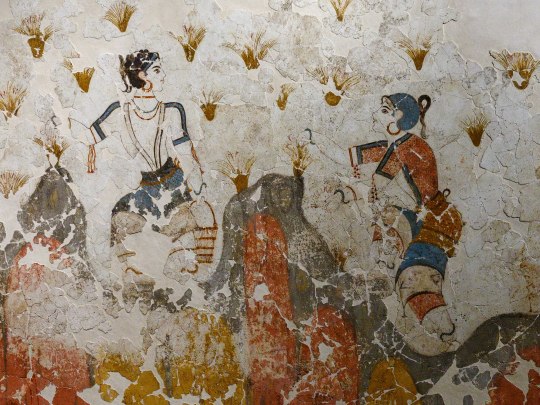
Another option is leaving the fringes loose, as seen in the Akrotiri frescoes from Xeste, room 3:
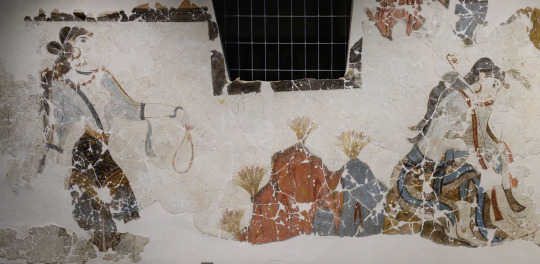
The final garment was super comfy, actually! It's much simpler to create than I thought it would be based on the frescoes, which made it all feel pretty magical when everything came together. I did think it was a little unusual how tailored this garment is, and the potential waste of fabric that comes from a shaped garment, especially compared to how later ancient greek clothing was mainly rectangles. I don't know enough about bronze-age and earlier clothing to have any idea how typical this was, since I'm extremely Not an expert on this subject, but am always open to learning more!
477 notes
·
View notes
Text
“Hermes appears on Linear B tablets from the mainland and, possibly, Crete (Nosch 2000, passim). The name Hermes derives from the word for cairn, or mound of stones. This derivation introduces many aspects of the god’s persona. Cairns were used to mark boundaries, mainly of personal or political territories; Hermes was the traveling god who crossed boundaries. Cairns were used to bury the dead; Hermes is the psychopompos, or “guide of souls,” who brought mortals and immortals to and from Hades. With this access to the underworld, Hermes became the patron of magic, especially of curses. Cairns were, inevitably, roughly formed; Hermes was frequently revered in the form of the herm, a stone block with the god’s head on top and an erect phallus on the side. These images were used to mark boundaries. Those most likely to cross boundaries were merchants and (closely related to merchants) pirates. Associations with both led to Hermes’s identity as the thieving trickster, emblematic of cunning intelligence.”
- The Ancient Greeks: New Perspectives, by Stephanie Lynn Budin
1 note
·
View note